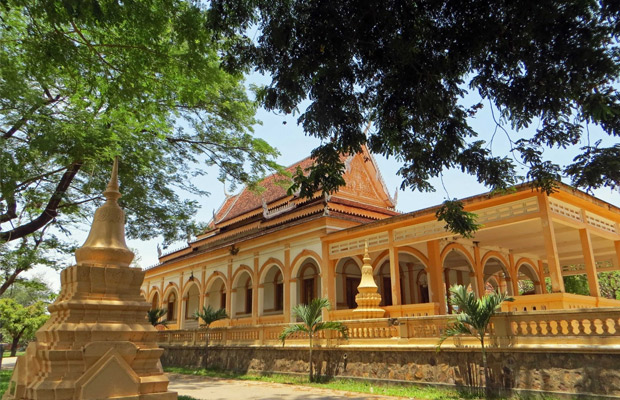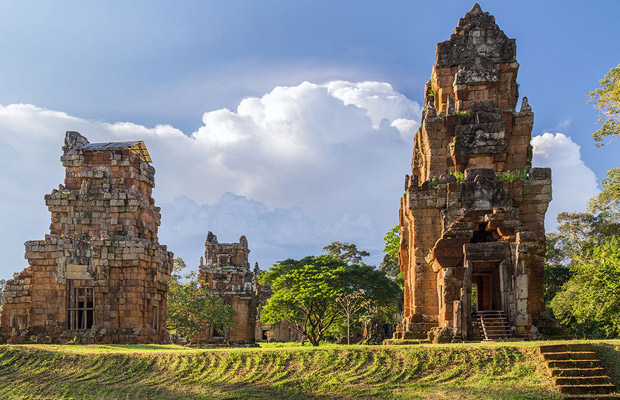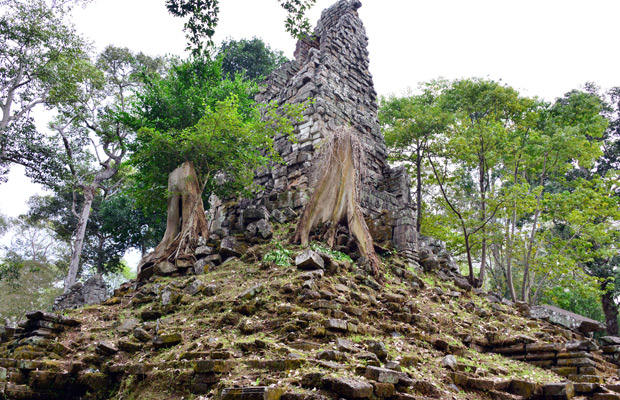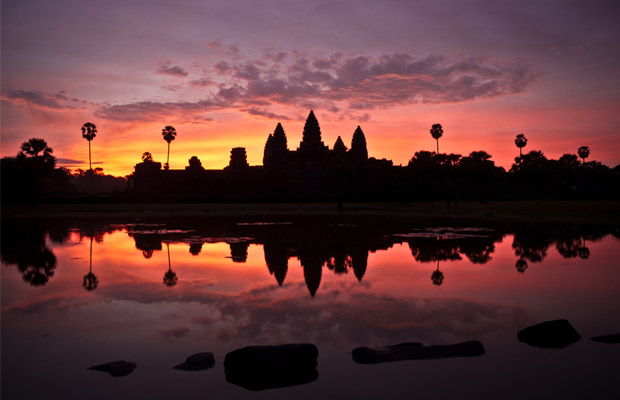Banteay Samre Temple
Banteay Samre is one of the most complete complexes in Angkor due to restoration using the anasthylosis method. Unfortunately, the lack of maintenance in the last 20 years is evident.
Banteay Samre is one of the most complete complexes in Angkor due to restoration using the anasthylosis method. Unfortunately, the lack of maintenance in the last 20 years is evident.
Samre's name refers to an ethnic group of mountain people, who inhabited the regions at the base of Phnom Kulen and were probably related to the Khmers. No inscriptions were found for this temple, but the style of most of the architecture is of the classic art of the middle period similar to Angkor Wat. The monument probably dates from the same period, or perhaps a little later, though there are additions attributed to the Bayon style.
The proportions of Banteay Samre are presented. A unique feature is an internal moat with laterite pavement, which when filled with water must have given an ethereal atmosphere to the temple. All the buildings around the moat are in a raised base with horizontal frames, decorated in some areas with figures framed by lotus buds.
Large temple, comparatively flat, displaying an architecture and an Angkor Wat style art. The temple underwent an extensive restoration in this century by archaeologists using the method of anastilosis. Banteay Samre was built at the same time as Angkor Wat. The style of the towers and balustrades bears a strong resemblance to the towers of Angkor Wat and even more so with the Khmer temple of Phimai in Thailand. Many of the sculptures are in excellent condition. Banteay Samre is slightly off the Grand Circuit, near the southeast corner of East Baray. The trip is a small and pleasant 3 km excursion through villages and fields. Combine a visit to Banteay Srey with a stop at Banteay Samre on the way back.
View Mores Temple Guide

Phnom Kulen
The Phnom Kulen mountain range is located 30 km north of Angkor Wat. Its name means "mountain of lychees". [3] There is a sacred site at the top of the hill. Phnom Kulen is considered a sacred ...

Wat Bo Pagoda
Wat Bo Pagoda, near the Siem Reap River on the east side, is one of the oldest in Siem Reap and a peaceful place to escape and take a break to visit the main sites of the nearby Angkor ...

Preah Vihear Temple
Preah Vihear Temple (Khmer: ប្រាសាទព្រះវិហារ Prasat Preah Vihea) is an ancient Hindu temple built during the period of the Khmer Empire, which sits atop a 525-meter ...

Prasat Prei
Small temple ruins unite in a forest setting near Neak Pean. Remains of a gopura, the central tower and halls, and the vestiges of a library and surrounding wall. Some apsara and lintel sculptures. A ...

Cambodia Culture Village
The Cambodian cultural village situated in the province of Siem Reap along the number 6 road distanced itself 3 km from the International Airport of Siem Reap and 5 km from the temple of Angkor Wat, ...

Wat Damnak
Wat Damnak is located near Phsar Chas aka Old Market, just opposite the Siem Reap River. If you were to stroll the Old Market, you would see the stone bridge directly in its southeast corner. Stroll ...

Khleangs(North Khleang and South Khleang)
The Khleangs are two buildings of unknown purpose on the east side of Royal Square in Angkor Thom, Cambodia, located just behind the twelve towers of Prasat Suor Prat and separated by the royal route ...

Lolei Temple
Lolei (Khmer: ប្រាសាទលលៃ) is the northernmost temple of the Roluos group of three Hindu temples from the late 9th century in Angkor, Cambodia, whose other members are Preah Ko and ...

Preah Palilay
Preah Palilay (Khmer: ប្រាសាទព្រះបាលិលេយ្យ [1]) is a temple in Angkor, Cambodia. It is located in Angkor Thom, 400 m north-west of Phimeanakas. This small ...

Prasat Leak Neang
Prasat Leak Neang (Khmer's "Tower of the Hidden Virgin") is a small, 200 m east of Pre Rup, lying Prasat in Angkor. According to an inscription, the building dates from 960 and was built under ...
.jpg)
Angkor Wat Temple
Since the "discovery" of the temple of Angkor Wat, released in the mid-19th century, it was described as the largest religious building in the world and is rightly spoken as one of the wonders of the ...

Angkor Thom East Gate
The east gate of Angkor Thom was used as a location on the Tomb Raider, where the bandits entered the "tomb" pulling a giant polystyrene apsara. This is the most atmospheric of the gates of Angkor ...












